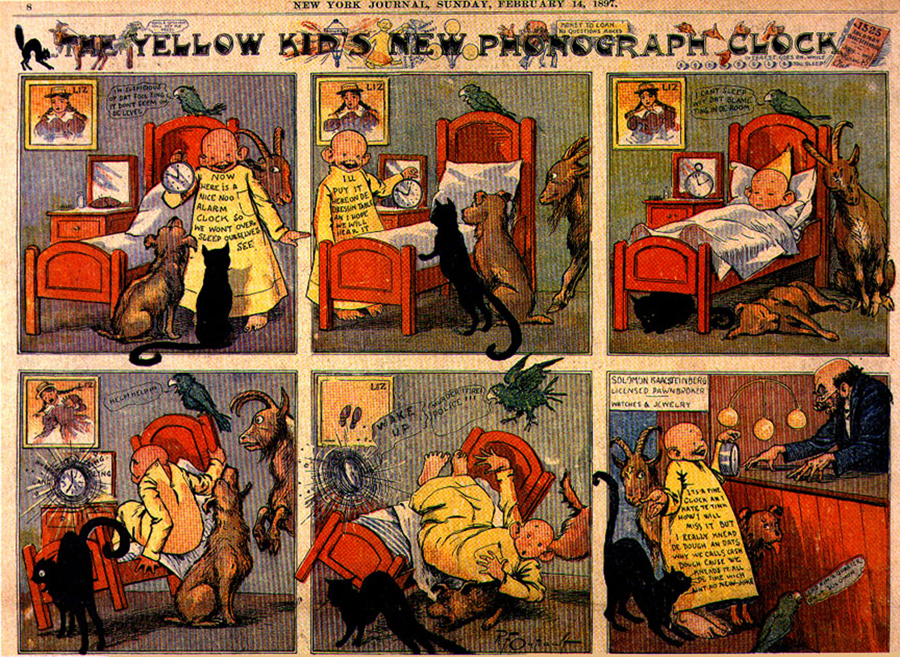| In the beginning, comic strips were
published exclusively as weekly features in the Sunday supplement
of American newspapers, originally created as a tool to draw customers
to the Sunday edition of the local newspaper (Halegua,
Online). The comic strips originally evolved from the
traditional cartoon. A "cartoon" was any single drawing
generally accompanied by a caption or a legend that conveyed a
message (Stephen Becker 2). It was
made popular due to the work of renowned cartoonists such as Thomas
Nast, Honoré
Daumier, and William
Hogarth. The advent of comic strips was not a sudden event,
but rather a gradual discovery. In the 18th and early
19th century, William Hogarth and Thomas
Rowlandson regularly used word balloons in their cartoons.
Rowlandson utilized "continuity", one story with one
cast appearing regularly, in his Tours
of Dr. Syntax (Becker 3).
In the 1870s and 1880s, American dailies and weeklies slowly incorporated
more comic-like pieces. One example of these pioneer comic strips
was Frank
Bellew’s six-panel strip in 1881 called Mr.
Bowler’s Midnight Encounter (Becker
3). |
|
Although there were evidences of early
comic form in American newspapers, the birth of the genre came
in 1896 in The
Yellow Kid by Richard
Felton Outcault, which appeared in Joseph
Pulitzer’s New
York World (Becker 10).
The "kid" was bald with flap ears; he had a wise, slightly
Chinese face. The Yellow Kid’s nightshirt usually was the focal
point of the drawing; it was a billboard with a message. The significance
of The Yellow Kid was that the written word had moved into
the drawing, and it was no longer simply a caption or a legend.
Words began to reflect the humor of the drawing, and vice versa
(Becker 11). Next came Rudolph
Dirks' the Katzenjammer
Kids (1897), which was the first to make consistent use
of a sequence of panels to tell the stories. The Katzenjammer
Kids combined both the aspect of internal dialogue and panelized
continuity (Halegua, Online), and
Dirk established the foundation for which succeeding comic strips
follow. With the appearance of pioneering strips such as Happy
Hooligan by Frederick
Burr Opper, Carl
E. Schultze’s Foxy
Grandpa, Outcault’s Buster
Brown, and James
Swinnerton’s Little
Jimmy (The Columbia Encyclopedia, Online),
all the essential components of the comic strip, such as regularity
of cast, use of sequence of panels, and speech-balloons, were
refined and securely established. |
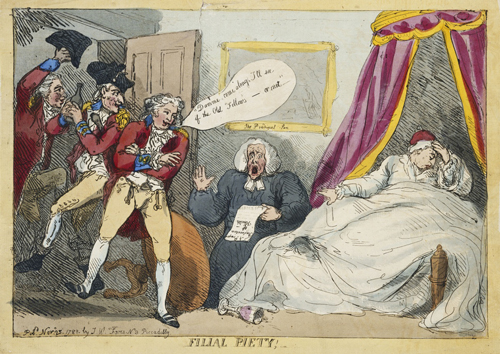 Rowlandson
Rowlandson |
|
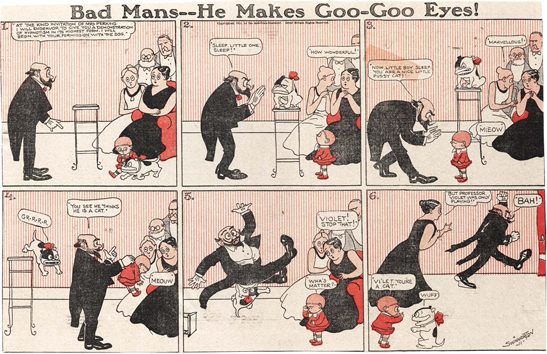 Swinnerton
Swinnerton |
| By the early 1900s, there were well over 150 strips
in America, in addition to numerous strips that were in publication
for local papers. Up to this point, the majority of comics were
humorous. Winsor
McCay introduced a new type of genre with Little
Nemo in Slumberland that appeared from 1905-1911 in the
New
York Herald (Halegua, Online).
The strip was centered on the dreamt adventures of a small boy
named Nemo and his friends. Nemo's adventures extended through
several weeks, and McCay’s comic was somewhat of an adventurous
fantasy and at times mild soap opera. In 1924, Roy
Crane’s Washington
Tubbs II introduced the idea of adventure comics (Halegua,
Online). Edgar
Rice Burroughs followed up with the idea with his famous
comic Tarzan.
Soon other genres of comics emerged, such as science-fiction tales
in Princess
of Mars, also by Burroughs, and the detective strips
of Dick Tracy
(1931) by Chester
Gould. By the time of the great depression, Americans
turned to comic strips as one of the ways to escape from their
dreary daily life. |
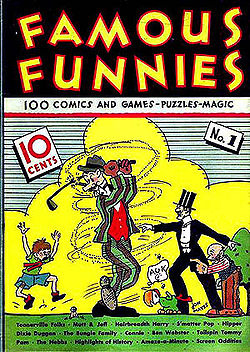 Jon Mayes
Jon Mayes |
In 1933, the comic world was about to change; the
arrival of the first comic book was a surprise to all, and the
eventual success is now truly history. Publishers at Eastern
Color Printing were figuring out a way to efficiently
use their printing equipment, which was frequently idle between
jobs. Maxwell
Gaines, father of William
F. Gaines, EC
Comics & Mad
Magazine publisher, came up with the idea of printing
an eight page comic section that could be folded down from the
large broadsheet to a smaller nine inch by twelve inch format.
The result was the first modern comic book. The name was Funnies
on Parade, and it contained reprints of newspaper comic
strips and was given away for free. Realizing that there was a
market for repackaged strips, the following year Eastern published
Famous Funnies
and sold it for ten cents through chain stores (Halegua,
Online). |
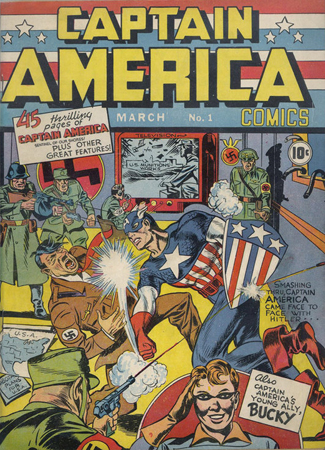 Simon and Kirby
Simon and Kirby |
The Golden Age of comic history was creeping up,
and all it needed was something to ignite the fuel. From the creative
minds of Jerry
Siegel and Joe
Shuster came Superman.
The idea was heavily inspired by Philip
Wylie's 1930 novel Gladiator
(Derek Santos, Online). Though
Siegel
and Shuster thought they had discovered a goldmine, selling
their idea to newspapers turned out to be a difficult task. They
were hit with rejection after rejection from newspaper such as
the Bell
Syndicate and United
Features. The strips finally made its way into the hands
of McClure
Syndicate editor Sheldon
Mayer who immediately fell in love with it. Mayer then
passed the idea up to Harry
Donenfeld of DC
Comics, who agreed to buy the strips. The first issue
appeared in the news stands in May 1938. Superman was born and
the rest is history. The success of Superman kick starts a revolution
of superheroes in comic books. Along came Batman by Bob
Kane, who made his first appearance in Detective Comics
No. 27 in May 1939 (Santos, Online).
The time of World War II marked the arrival of Captain
America. Created by Jack
Kirby and Joe
Simon, its first issue came out in February of 1941 (The
Columbia Encyclopedia, Online). By this time, comic
strips and comic books began to diverge from each other. Comic
books stood as the domain of the superheroes. |
| As the world war ended, so did the golden age of
superheroes. Other genres in the realm of comic arts began to
flourish.
Walt Disney’s Comics and Stories became more and more
popular. Crime comics became a huge success with "Crime
Does Not Pay". Horror comics crashed onto the scene
in 1948, and by 1950 E.C.
Comics had three horror titles on the stands, Crypt
of Terror (later Tales from the Crypt), Haunt of
Fear and Vault
of Horror. These comics raised the bar with their gory
art and violent storyline. |
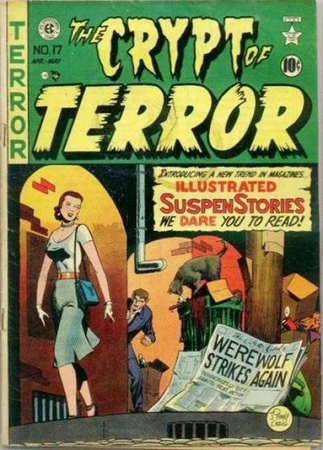 Johnny Craig
Johnny Craig
|
In 1940, Dr.
Frederic Wertham published a book called Seduction
of the Innocent accusing comic books to " systematically
poisoned the wellspring of children’s spontaneity and prepared
the ground for later aggressive behavior." ( Reinhold
Reitberger and Wolfgang Fuchs 132). Dr. Wertham viewed
that comics seduced the reader into a future of crime and sexual
perversions. On October 26, 1045 the Comics
Code of the CMAA came into effect. It regulated and
forbade many things in comics, including no two piece bathing
suits, criminals must pay for their crimes, no blood or gore,
and words like weird, horror and terror could
not be published on the covers ( Halegua,
Online). The comic world took a huge blow as sales
plummeted, almost all crime comics went out of business, DC
had only a couple dozen titles left, and Atlas
(which later became Marvel)
was almost out of business. |
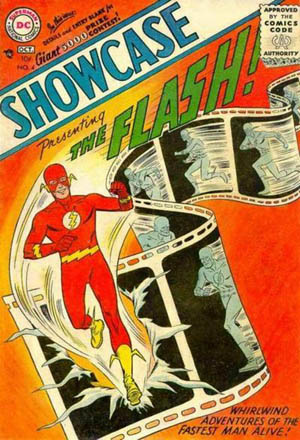 Carmine Infantino and Joe Kubert
Carmine Infantino and Joe Kubert |
The comic world needed something to catapult it
back on its feet, and Julius
Schwartz of DC comics brought in The
Flash. Written by Robert
Kanigher and illustrated by Carmine
Infantino, the Flash made its debut on the stands in September
of 1956, and his origin story was a success. Then came the "Brave
& the Bold" #28, dated February-March of 1960
(Halegua, Online). The Justice
League of America was formed by the Flash, Green Lantern,
Wonder Woman, Martian Manhunter and Aquaman, with Batman
and Superman making occasional cameos. Their popularity
grew exponentially, and it kick started the second age of superheroes.
|
| Creeping behind DC’s superheroes success, Marvel
comics was about to make its mark in history. Seeing the success
of DC’s Justice League of America, Martin
Goodman worked with Stan
Lee and Jack
Kirby to create their own superhero team. The Fantastic
Four made its first appearance in September of 1961 (Santos,
Online). Its success was overwhelming. Marvel followed
that up with the Incredible Hulk in May 1962. Stan Lee
then flirted with the idea of a "spider-hero" with Martin
Goodman. This led to the creation of arguably the second most
famous comic superhero of all time, Spider-Man. Spider-Man
debuted in Amazing
Fantasy on cover dated August of 1962 (Halegua,
Online). In many following years, Jack Kirby and Stan
Lee would introduce numerous heroes into the comic world such
as Giant Man, The Mighty Thor, Iron Man, and reintroduce
characters like the Sub-Mariner
and Captain America. The massive success of Marvel comics
was due to the fact that their superheroes differed from DC’s.
Superman and Batman chose the path to heroism and
they did not possess the regular problems of ordinary people.
Marvel heroes, on the other hand, were beset by human problems.
"The Thing" didn't want to be an ugly monster,
nor did Bruce Banner want to change into The Hulk, a creature
with uncontrollable rage. Peter Parker had all the ordinary
problems that a teenager could relate to. And August of 1975 marked
the
reintroduction of The X-Men, another by-product of comic
genius Stan Lee (Santos, Online).
The franchise would flourish into success and maintain popularity
in our contemporary culture. |
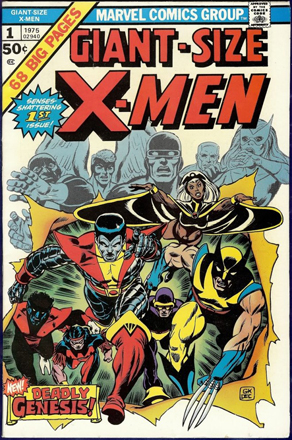 Gil Kane and Dave Cockrum
Gil Kane and Dave Cockrum |
We all have come to understand that pictures strike
us more efficiently than words. The cliché, "a
picture is worth a thousand words," exemplifies
the significance of comic arts in America. From cave paintings
to the Yellow Kid to Superman, comic arts have had a long
and lasting history. What started out as just an advertisement
scheme to draw customers to the Sunday edition of the local
newspaper has manifested itself into a profitable entertainment
business. Comic books now stand on separate grounds from
comic strips, but the relation and transition from one to
the other is undeniable.
|
Work Cited
Becker, Stephen. Comic Art in America. New
York: Simon and Schuster, Inc., 1959.
Halegua, Richard. Comic Art. 2001. 18 July. 2004 http://www.comic-art.com/index.htm
Reitberger, Reinhold, and Wolfgang Fuchs. Comics: Anatomy of a
Mass Medium. Boston: Little, Brown and Company, 1970.
Santos, Derek. The Comic Page. 22 July, 15 July 2004 http://inventors.about.com/gi/dynamic/offsite.htm?site=http://www.dereksantos.com/comicpage/comicpage.html
The Columbia Encyclopedia, Sixth Edition. "Comic
Strips". Copyright © 2003 Columbia University Press.
http://www.comic-art.com/history/history1.htm (The Yellow
Kid)
http://www.comic-art.com/history/history3.htm (Funnies on
Parade)
http://www.comic-art.com/history/history5.htm (Captain America
and Crime Does Not Pay)
http://inventors.about.com/GI/dynamic/offsite.htm?site=http://www.dereksantos.com/comicpage/comicpage.html
(Superman and Batman)
http://www.bdoubliees.com/echodessavanes/sfig1/katzen.jpg (The
Katzenjammer Kids)
http://www.comic-art.com/history/history9.htm (Spiderman
and Incredible Hulk)
http://www.biglittlebooks.com/images/Dell%20Dick%20Tracy%20Fed%20hard%20c%20.jpg
(Dick Tracy)
|
